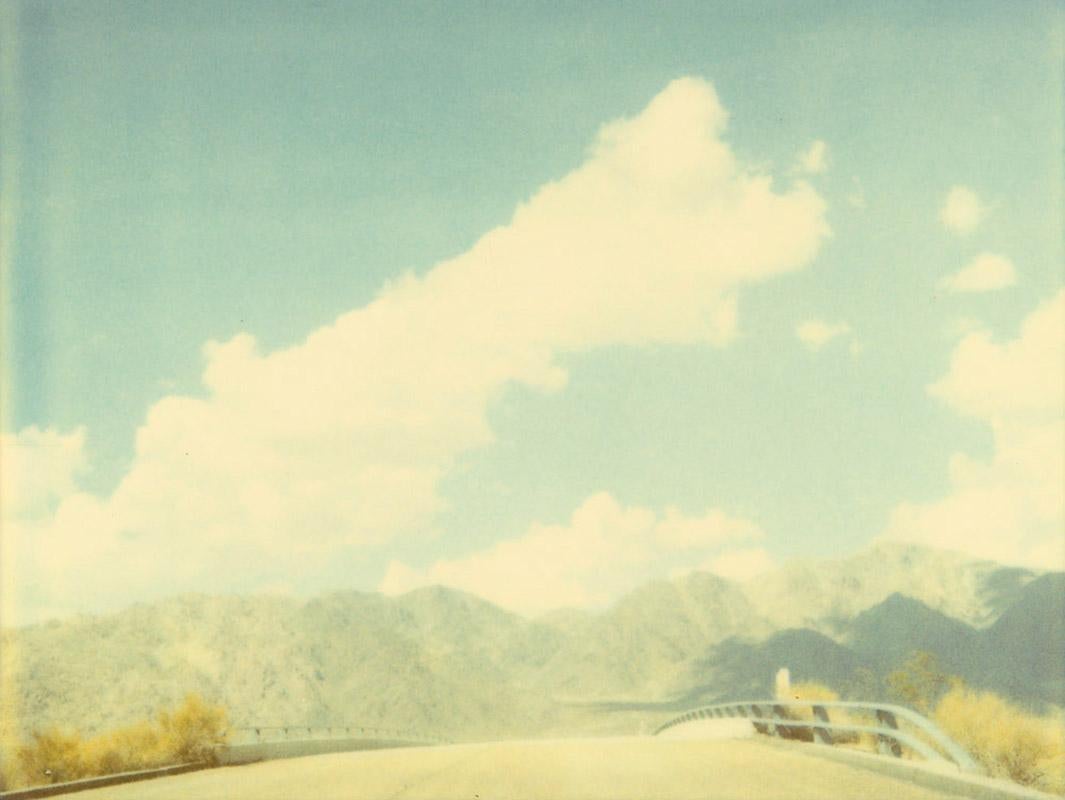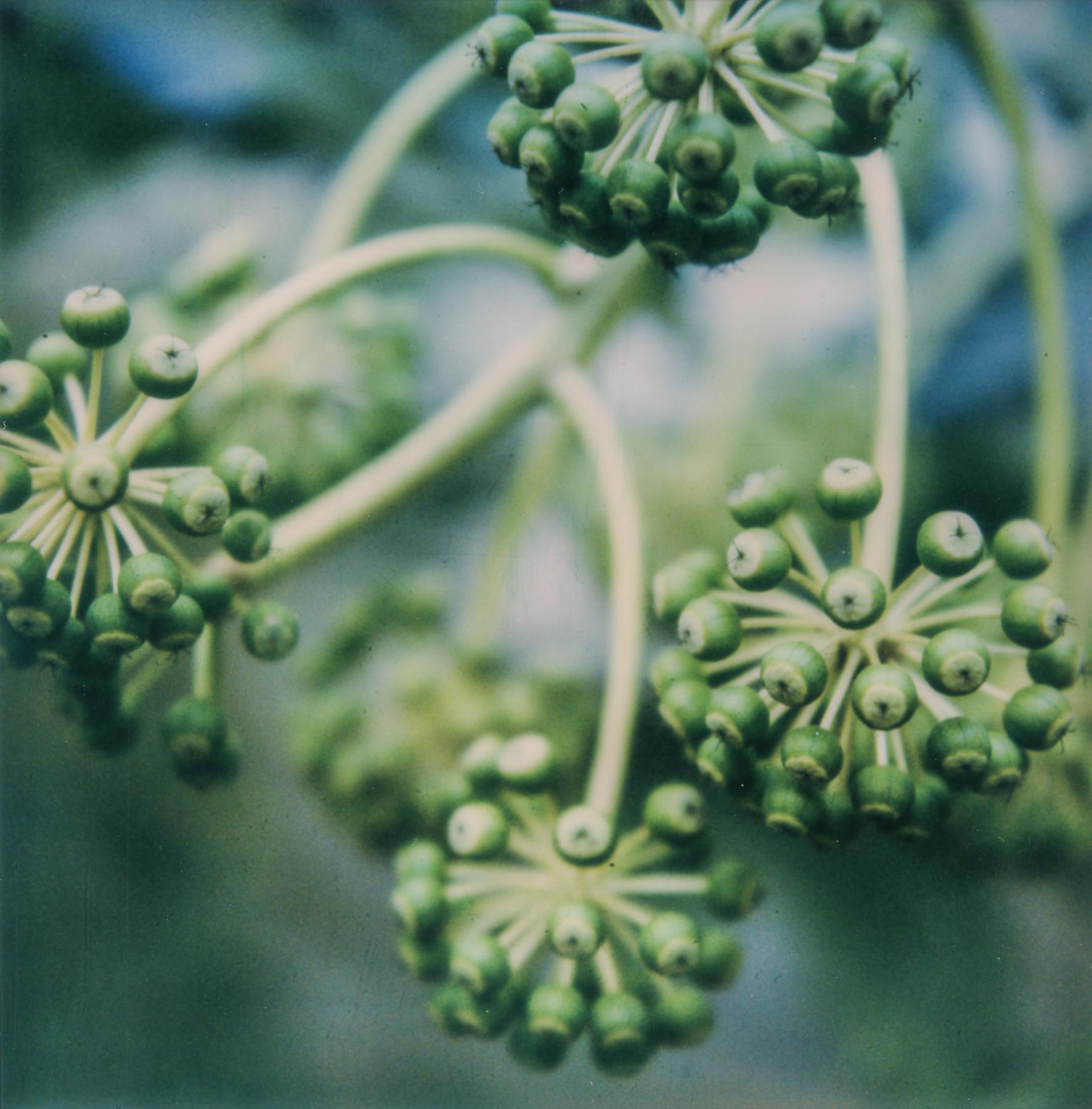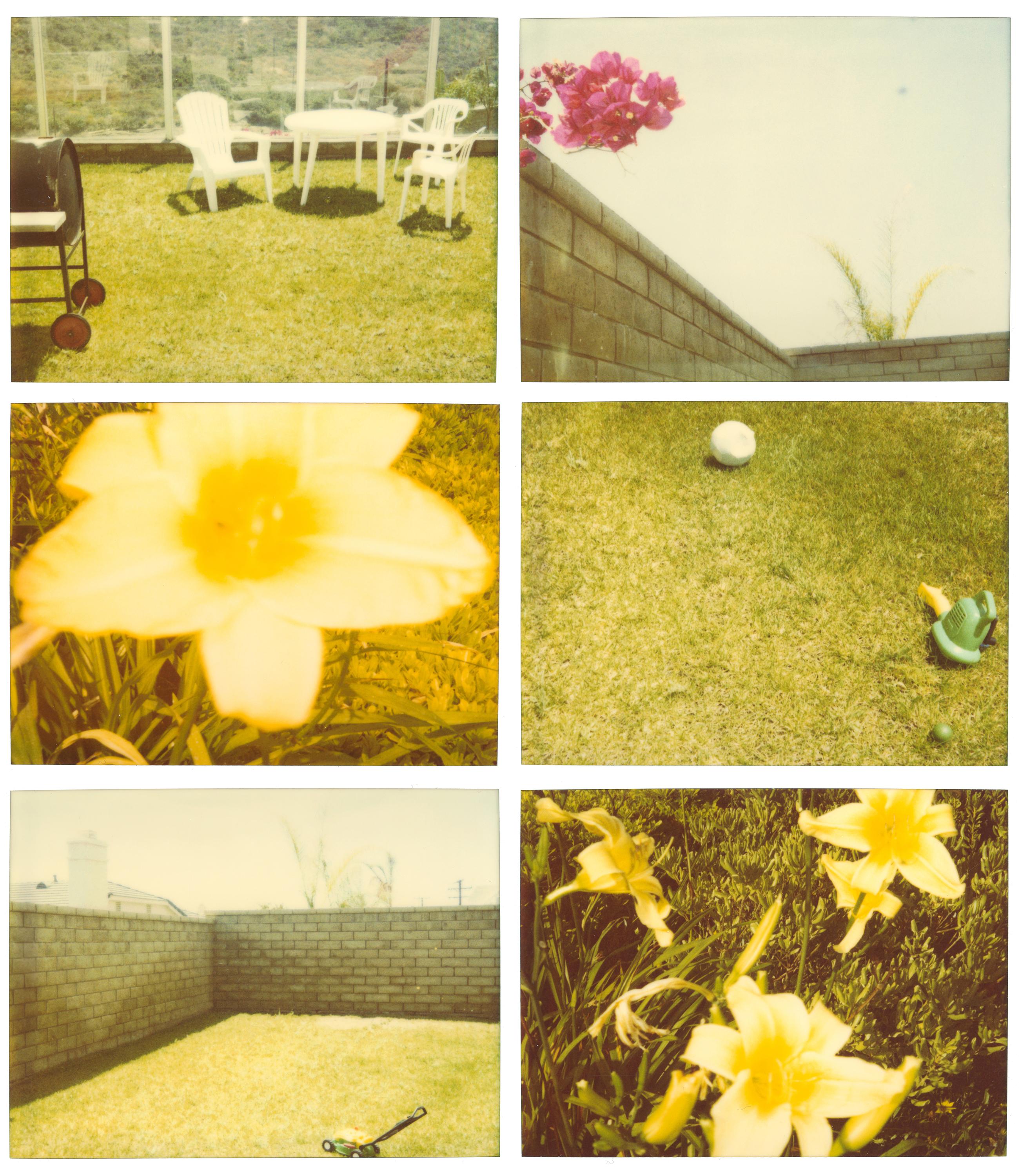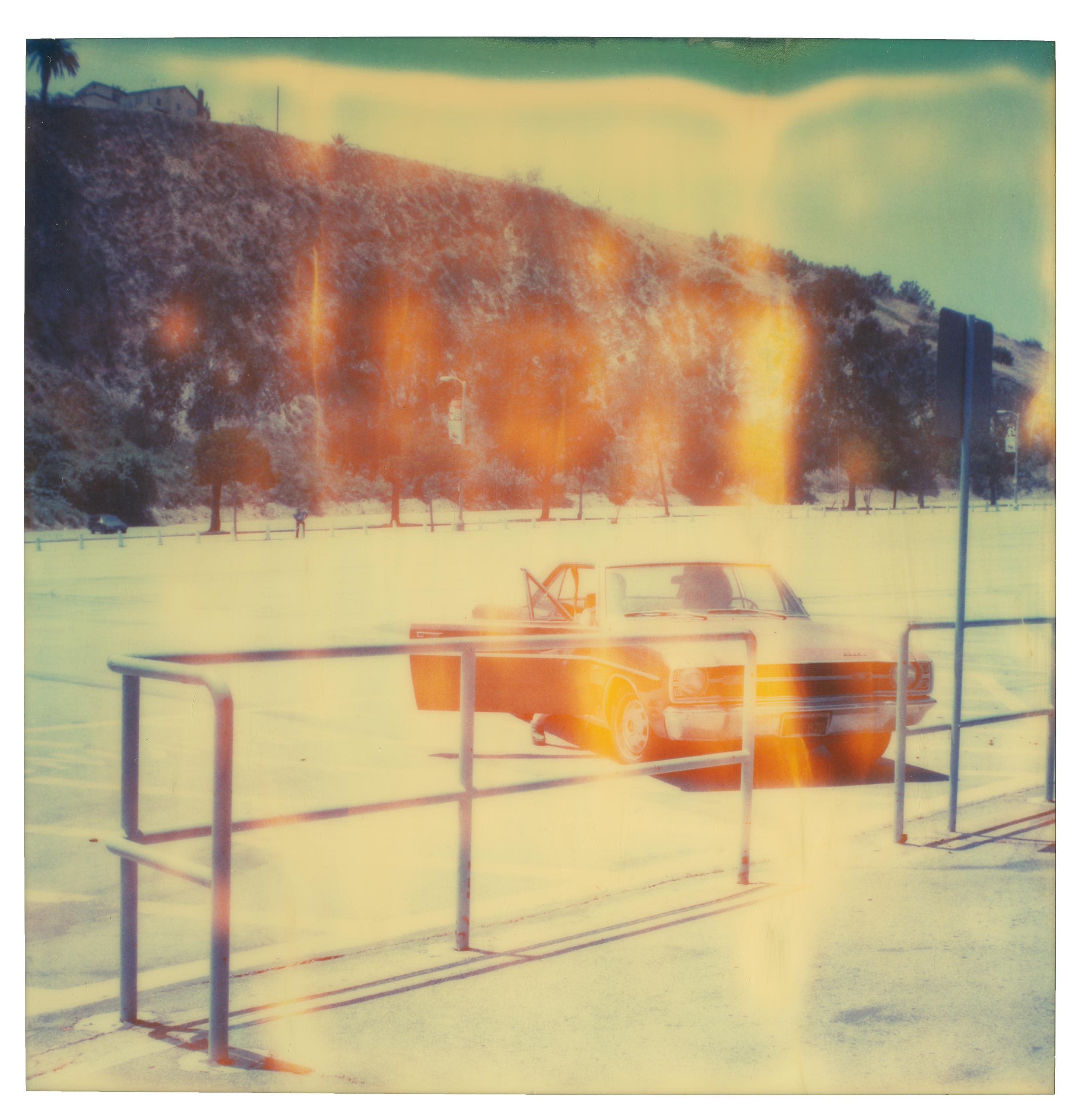Items Similar to Gasoline IIb - Stranger than Paradise
Want more images or videos?
Request additional images or videos from the seller
1 of 9
Stefanie SchneiderGasoline IIb - Stranger than Paradise1999
1999
About the Item
Gasoline IIb (Stranger than Paradise) - 1999
Edition of 10,
39x37cm.
Archival C-Print, based on a Polaroid
Artist inventory Number 270b.
Not mounted.
Stefanie Schneider: A German view of the American West
The works of Stefanie Schneider evoke Ed Ruscha's obsession with the American experience, the richness of Georgia O'Keefe's deserts and the loneliness of Edward Hopper's haunting paintings. So how exactly did this German photographer become one of the most important artists of the American narrative of the 20th and 21st century?
Born in Germany in 1968, photographer Schneider used to divide her time between Berlin and Los Angeles from the 90's until settling permanently where her process begins in the American West, in locations such as the planes and deserts of Southern California, where she photographs her subjects. In Berlin, Schneider developed and enlarged her works by hand. That changed in 2020 when the complete process was moved to Southern California permanently.
This theme of preservation and deterioration is a core part of Schneider's oeuvre. In an interview in October 2014 with Artnet, the artist explained how her own experiences of pain and loss inspire her. ''My work resembles my life: Love, lost and unrequited, leaves its mark in our lives as a senseless pain that has no place in the present.''
''The ex-lover experiences the residues of love as an amputee experiences the sensation of a ghost limb.'' - Stefanie Schneider
Schneider's subjects are often featured in apocalyptic settings: desert planes, trailer parks, oilfields, run-down motels and empty beaches, alone, or if not, not connected with one another. ''It is the tangible experience of ''absence'' that has inspired my work,'' explained Schneider.
Barnebys, May 3rd, 2017
Stefanie Schneider interviewed by Dutch Filmmaker Willem Baptist
When did you first decide to work with Polaroids? Why do Polaroids seem to be so well tuned to our (artistic) senses, perception and minds?
I started using expired Polaroid film in 1996. It has the most beautiful quality and perfectly encapsulates my vision. The colors on one hand, but then the magic moment of witnessing the image appear. Time seems to stand still, and the act of watching the image develop can be shared with the people around you. It captures a moment, which becomes the past so instantly that the decay of time is even more apparent; – it gives the image a certain sentimentality. The Polaroid moment is an original every time. An artifact.
Why use a medium from the past?
For me, analog has always been there in the present. For the new generation, analog is interesting because it's new to them. I understand that people growing up in a digital age will wonder about its usefulness, but it's theirs to recover if they want to. When I first started working with Polaroid, it wasn't the past. It was a partially forgotten medium, but it existed nonetheless. It is mine by choice as there is no substitute for tangible beauty.
Is it imperfect?
The imperfect perfection in a “wabi-sabi” kind of way.
Wabi-sabi (侘寂) represents a comprehensive Japanese world view or aesthetic centered on the acceptance of transience and imperfection. The aesthetic is sometimes described as one of beauty that is imperfect, impermanent, and incomplete.
'If an object or expression can bring about, within us, a sense of serene melancholy and a spiritual longing, then that object could be said to be wabi-sabi'. 'Wabi-sabi nurtures all that is authentic by acknowledging three simple realities: nothing lasts, nothing is finished, and nothing is perfect.'
Is the Polaroid photograph recognizable or even sometimes cliché?
Absolutely! There's something cliché about the way I'm showing the American Dream. I live it myself, trying to find perfection in an imperfect world. Reaching for the horizon. The dream is broken; the cliché tumbles. There are different ways to involve an audience. You could make movies like Harmony Korine's 'Gummo' a masterpiece in my view but which would probably estrange a large part of an audience. A certain film education is a prerequisite. Or you can start with clichés, the audience then feels safe, which lures them into the depth of your world without them even knowing it or understanding where exactly they are being led to. Appealing to emotions and the sub-conscious. Normal, Change, New Normal.
You continually revisit the landscape of the American West in your work. What draws you back to this scene?
Southern California represents a dream to me. The contrast of Northern Germany, where I grew up, to the endless sunshine of Los Angeles was what first attracted me. The American West is my dream of choice. Wide, open spaces give perspectives that articulate emotions and desires. Isolation feeds feelings of freedom or sometimes the pondering of your past. The High Desert of 29 Palms has very clear and vivid light, which is vital. Expired Polaroid film produces 'imperfections' that I would argue mirrors the decline of the American dream. These so called 'imperfections' illustrate the reality of that dream turning into a nightmare. The disintegration of Western society.
Are you playing with the temporality of the material and the value of the moment itself?
The value of the moment is paramount, for it is that moment that you're trying to transform. All material is temporary, it's relative, and time is forever.
Why does analog film feel more pure and intuitive?
It's tangible and bright and represents a single moment.
The digital moment may stay in the box (the hard drive / camera / computer etc.)
forever, never to be touched, or put into a photo album, sent in a letter, or hung on a wall.
Printing makes it an accomplishment.
The analog world is more selective because it's real. Film is a choice.
The digital worldwide clicking destroys this moment. The generation without memories due to information overload and hard drive failures. Photo albums are a thing of the past.
Why does it feel this way?
That's how the human instinct works. When I was a child, every picture been taken was a special moment. Analog photographic film as well as Super-8 material were expensive treasures. My family's memories were created by choosing certain moments in time. There was an effort behind the picture. The roll of film might wait months inside the camera before it was all used. From there, the film required developing, which took more time, and finally, when the photos were picked up from the shop, the memories were visited again together as a family. Who knew then, how fleeting these times were. Shared memories was a ritual.
What's your philosophy behind the art of Polaroid pictures?
The 'obsolete' is anything but obsolete. Things are not always as they appear, and there are hidden messages. Our memories and our dreams are under-valued. It is there that real learning and understanding begins by opening yourself to different perspectives. Who we are and where we come from is important. A Polaroid is a testimony to our existence. But our time is fading fast.
What inspired you to use stop motion cinematography?
My work has always resembled movie stills. I remember the first time I brought a box of Polaroids and slid them onto Susanne Vielmetter's desk (my first gallery). Instantly, it became apparent that there was a story to tell. The stories grew. It was undeniable to me, that the emerging story was where I was destined to go. I've made four short films before my latest feature film, The Girl behind the White Picket Fence. This film is 60 minutes long with over 4000 edited Polaroids. Remember that our sub-conscious fills in blanks, the parts missing from the story between photograph stills allow a deeper and more personal experience for the viewer. That is, if you surrender yourself and trust me as the director to lead you somewhere you might not have ever been before.
Why do you think it is important to own art?
'We have art in order not to die of the truth'
Nietzsche
Stefanie Schneider's new photographic works tell fantastic stories about her adopted Californian home. She seeks out faded American myths and distils auratically charged reality in a very personal and surprising way. She uses out-of-date Polaroid film, and the blemishes caused by the degenerated film stock, - are included in the composition in a painterly way. Exposure mistakes and low budget movie effects are combined to alienating effect. Everything shimmers and flickers before our eyes. The artist plays with the authentic poetry of the amateur, mixing strangely dreamy staging with random photochemical events. In the 16-part work Frozen, which is characterized by a strangely transcendent mood in the lighting, film-still-like pictorial clusters come together to form a mysterious story, with the artist herself as the lonely protagonist. the aesthetic is reminiscent of early Lynch films. The components of the elliptically choreographed events are scenes from an enchanted, gleaming winter landscape, together with "staged snapshots" of a pale young woman in her underskirts, who radiates the troubled reality of a mirage with her sleep walking presence. The story is presented in the manner of cinematic flashbacks or dream sequences. Stage blood and a knife are used to evoke a crime of passion whose surreal attractiveness is derived from the scenic openess of what is shown. The deliberate use of old instant picture stock establishes in a richly faceted way the ephemeral quality of vulnerability and transience within a reality that is brittle from the outset. The American Stars and Stripes, recently updated as the absolute epitome of a patriotic signifier, is the subject of the 9-part work Primary Colors (2001). Schneider's reassuringly European view, free of undue emotion, presents the Stars and Stripes motif in a strangley alienated form: she shows stills with phases of fluttering violently in the wind, even torn in some cases, and the poor film stock emphazises the fragility of the icon even more.
FlashART - Sabine Dorothee Lehner (translated from German by Michael Robinson)
- Creator:Stefanie Schneider (1968, German)
- Creation Year:1999
- Dimensions:Height: 15.75 in (40 cm)Width: 15.36 in (39 cm)Depth: 0.04 in (1 mm)
- Medium:
- Movement & Style:
- Period:
- Condition:
- Gallery Location:Morongo Valley, CA
- Reference Number:1stDibs: LU652310438282
About the Seller
4.9
Platinum Seller
These expertly vetted sellers are 1stDibs' most experienced sellers and are rated highest by our customers.
Established in 1996
1stDibs seller since 2017
953 sales on 1stDibs
Typical response time: 2 hours
- ShippingRetrieving quote...Ships From: Morongo Valley, CA
- Return PolicyA return for this item may be initiated within 7 days of delivery.
More From This SellerView All
- Blue Sky Palm Trees (Sidewinder) - 21st Century, Polaroid, LandscapeBy Stefanie SchneiderLocated in Morongo Valley, CABlue Sky Palm Trees (Sidewinder) - 2005 80x80cm, Edition of 10, plus 2 Artist Proofs. Archival C-Print, based on a Polaroid. Signature label and Certificate. Artist Inventory No. 3026. Not mounted. Exhibitions for this piece: 2008 Sidewinder / 29 Palms, CA, c.art-Galerie, Dornbirn, Austria (S), Sidewinder, Galerie Robert Drees, Hannover, Germany (S), Sidewinder, Galerie Thierry Librati, Paris, France (S), Sidewinder, Städtische Galerie am Mozartplatz, Salzburg, Austria (S) ("Frenzy", Poster Image Salzburger Festspiele // 2007 Sidewinder, Scalo Guye, Los Angeles, USA (S), the gallery is now located in Zurich // 2006 Sidewinder, Artwalk Amsterdam, Amsterdam, Netherlands, curated by Frans Oomen (G) publications of this piece: STRANGER THAN PARADISE published by Hatje Cantz Verlag, 2006 (monograph) // movie: 2005 SIDEWINDER - Director / Artist / Camera / Editing - starring JD Rudometkin, Stefanie Schneider, music by JD Rudometkin "private history turned into an intimate mythology of elemental fantasies where reality is perceived through a veil of psychedelic memories and unconscious projections. such is a collection of passions and dreams, an uncanny diary of ephemeral narratives and mental intensities in Stefanie Schneider’s painterly photographs where subjectivity of an ontological doubt uses a poetics of pastische as a vehicle for an intertextual journey towards the truth and the authenticity of primary emotions. here time is immersed in a nostalgic suspense of oneiric dimension, a sort of ambiguous coma of silence and comfort, and open space embraces a psychotic landscape of solitude and accidental pleasure. fetishized surface of extreme feelings gives a stage for an unsolicited promise of unconditional love and unlimited freedom, a promise framed by sensual tension between fulfillment and expectation." Adam Budak, Kusthaus Graz, 2005 Sidewinder There’s blood on the dress that hangs in the Airstream trailer outside 29 palms. With the pistol in her sweat palm touching his temple. Tell me what god’s gonna do for me and you know Stevie’s saying while Brother John Baptiste looks there across to where her cat seems weak and fed. All the good that comes to me from my believing man, I wanna hear about it said to me like that. Just the way you breathed it like you did 10 minutes ago when I was wrapped so well around your head. Silence then. A baby screams his mother out in the desert night...Category
Early 2000s Contemporary Color Photography
MaterialsArchival Paper, Photographic Paper, C Print, Color, Polaroid
- Mountain Ridge (Stranger than Paradise) - analog, vintage. mountedBy Stefanie SchneiderLocated in Morongo Valley, CAMountain Range (Stranger than Paradise) - 1999 55x72cm, Edition 3/5, Analog C-Print, printed by the artist, based on a Polaroid. Mounted on Aluminum with matte UV-Protection. Art...Category
1990s Contemporary Landscape Photography
MaterialsMetal
- Enchanted (Dream Scene on Salt Lake), triptychBy Stefanie SchneiderLocated in Morongo Valley, CA'Enchanted' (Dream Scene on Salt Lake), triptych, from the 29 Palms, CA Project Edition 4/10. Each 20x20cm, together 20x70cm (installed). 3 Archivall C-Prints, based on 3 SX-70 Po...Category
Early 2000s Contemporary Landscape Photography
MaterialsArchival Paper, Photographic Paper, C Print, Color, Polaroid
- Green - Contemporary, Nature, Polaroid, Flower, 21st Century, ColorBy Kirsten Thys van den AudenaerdeLocated in Morongo Valley, CAGreen - 2018, Edition 2/7 plus 2 Artist Proofs Archival C-Print, based on the original Polaroid. Signed on the back and certificate. Artist inventory PL2018-213. Not mounted. ...Category
2010s Contemporary Landscape Photography
MaterialsColor, Polaroid, Photographic Paper, Archival Paper, C Print
- Suburbia - analog, mounted, 6 pieces - Polaroid, ContemporaryBy Stefanie SchneiderLocated in Morongo Valley, CASuburbia (Suburbia) - 2004 Edition of 5, 60x80cm each, 200x170cm installed. 6 analog C-Prints, hand-printed by the artist on Fuji Crystal Archive Paper, matte surface, based on 6 o...Category
Early 2000s Contemporary Landscape Photography
MaterialsMetal
- Dodger Stadium (The Last Picture Show) - 21st Century, Polaroid, ColorBy Stefanie SchneiderLocated in Morongo Valley, CADodger Stadium (The Last Picture Show) - 2000 50x49cm, Edition of 10 plus 2 Artist Proofs. Archival C-Print, based on the original Polaroid. Artist inventory number: 782. Signat...Category
Early 2000s Contemporary Color Photography
MaterialsArchival Paper, Photographic Paper, C Print, Color, Polaroid
You May Also Like
- New York VI - 21st Century Contemporary Original Polaroid Photograph FramedBy Pia ClodiLocated in Salzburg, ATNew York VI - Framed Contemporary Original Polaroid Photograph Like much of Pia Clodi's work, 'New York VI' leaves a trace of the fast, nomadic life she leads. In this instance, C...Category
2010s Contemporary Landscape Photography
MaterialsArchival Paper, Photographic Paper, Polaroid
- Paris Walks I - Framed Contemporary Landscape Polaroid Original PhotographBy Pia ClodiLocated in Salzburg, ATParis Walks - Contemporary Black & White Polaroid Original Photograph Framed Pia Clodi’s works encompass moments and mementos from her countless walks through cities as well as nat...Category
2010s Contemporary Landscape Photography
MaterialsArchival Paper, Photographic Paper, Polaroid
- New York IV - Contemporary Landscape Polaroid Original PhotographBy Pia ClodiLocated in Salzburg, ATNew York IV - Framed Contemporary Polaroid Photograph Like much of Pia Clodi's work, 'New York IV' leaves a trace of the fast, nomadic life she leads,. Here, a photograph of a hig...Category
2010s Contemporary Landscape Photography
MaterialsArchival Paper, Photographic Paper, Polaroid
- New York III - Contemporary Landscape Polaroid Original Photograph FramedBy Pia ClodiLocated in Salzburg, ATNew York III - Framed Contemporary Original Polaroid Photograph Like much of Pia Clodi's work, 'New York II' leaves a trace of the fast, nomadic life she leads, this time doucment...Category
2010s Contemporary Landscape Photography
MaterialsArchival Paper, Photographic Paper, Polaroid
- New York V - Contemporary Landscape Polaroid Original Photograph FramedBy Pia ClodiLocated in Salzburg, ATNew York V - Framed Contemporary Original Polaroid Photograph Like much of Pia Clodi's work, 'New York V' leaves a trace of the fast, nomadic life she leads. This work is represen...Category
2010s Contemporary Landscape Photography
MaterialsArchival Paper, Photographic Paper, Polaroid
- New York II - Contemporary Landscape Polaroid Original PhotographBy Pia ClodiLocated in Salzburg, ATNew York II - Framed Contemporary Original Polaroid Photograph Like much of Pia Clodi's work, 'New York II' leaves a trace of the fast, nomadic life she leads, this time depicting...Category
2010s Contemporary Landscape Photography
MaterialsArchival Paper, Photographic Paper, Polaroid
Recently Viewed
View AllMore Ways To Browse
Stranger Things
Vision Of Paradise
Southern Desk
German Camera Case
Ed Ruscha Etc
Early Georgian Mirror
There Will Be Blood
Movie Artifacts
Low Japanese Box
Early California Mirrors
Japanese Ghost
Northern European Mirror
Large Surreal Landscape Painting
Dior Watch Case
Poor Box
Letter Knife
Ghost Watch
Japanese Fence Painting





